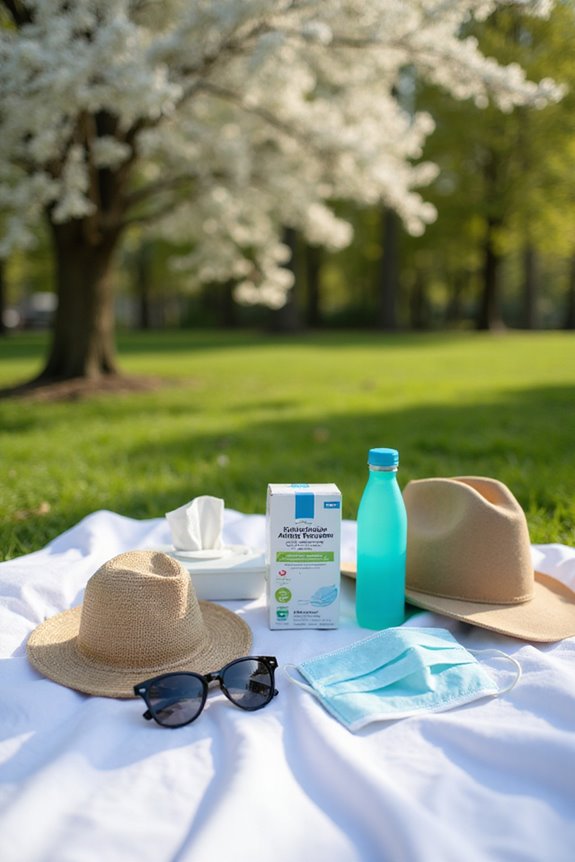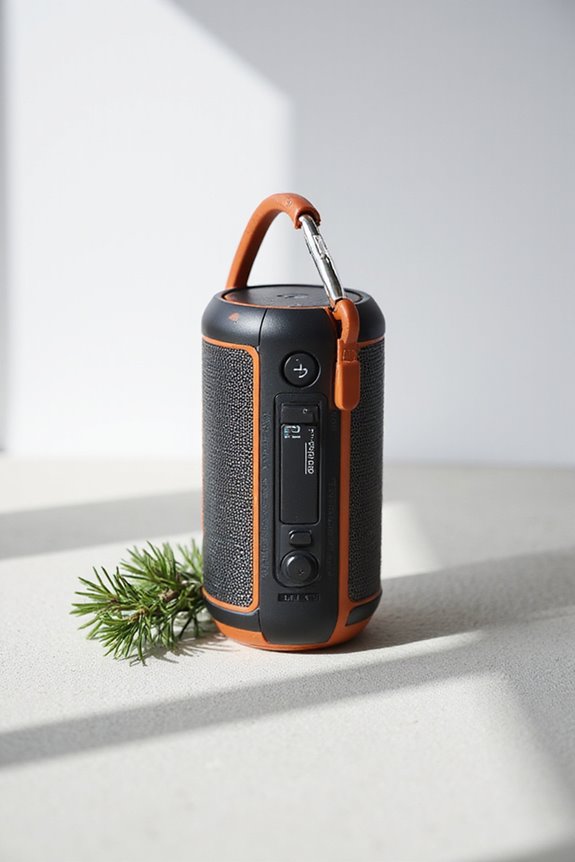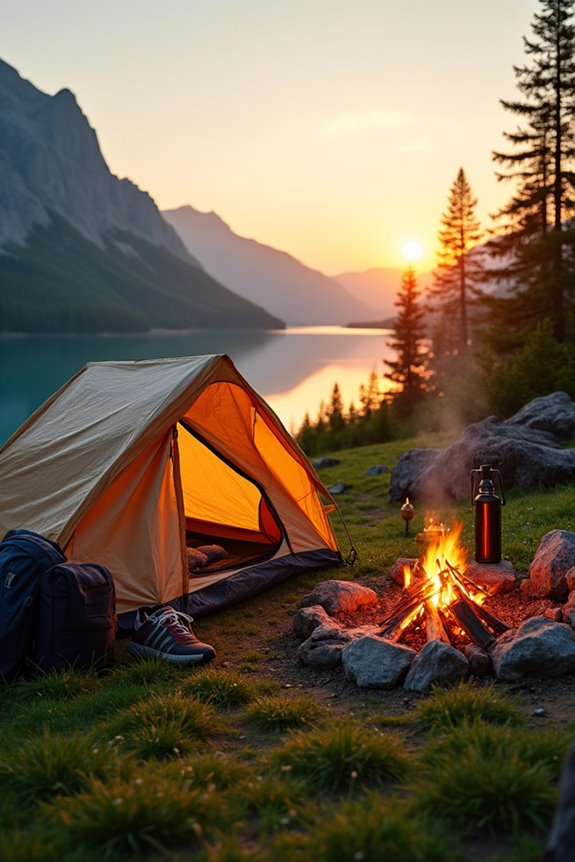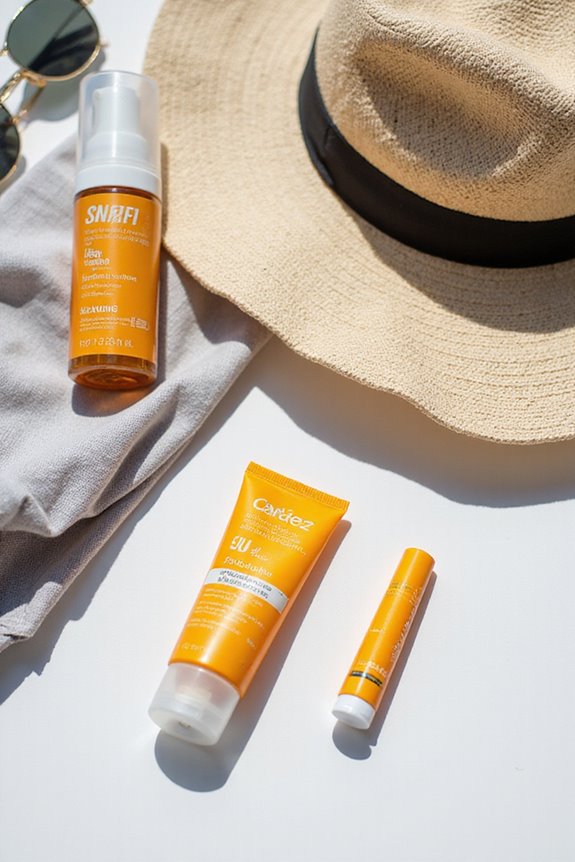Enjoying outdoor activities during allergy season is all about timing and preparation. Early morning or late afternoon are the best times to enjoy the fresh air while keeping pollen at bay. Opt for low-key activities, like nature walks or scenic drives, and consider hypoallergenic plants if gardening. Don’t forget your protective gear—masks and sunglasses help! Remember to check pollen counts and pack your allergy medication. There’s a world of allergy-friendly adventures waiting for you to explore!
Key Takeaways
- Plan outdoor activities early in the morning or late afternoon when pollen counts are lower.
- Choose hypoallergenic plants for gardening and wear a mask to reduce exposure.
- Check local pollen counts before outings and adjust plans accordingly.
- Engage in low-impact activities like nature walks or scenic drives to minimize allergy symptoms.
- Pack allergy medications and stay hydrated to manage symptoms during outdoor adventures.
Understanding Allergy Triggers by Season
As spring blooms with vibrant flowers and the sweet scent of fresh grass fills the air, many people find themselves caught in a sneeze-inducing whirlwind of pollen. Seasonal symptoms can turn the joys of spring into a struggle, especially for the over 80 million people in the U.S. affected by allergies. The primary pollen sources during this time are trees, with cedar and maple leading the charge from late winter through April. As tree pollen peaks, the air thickens, and sniffles become common. Soon after, grass pollen joins the fray, keeping allergy sufferers on high alert. With climate change extending these pollen seasons, it’s essential for everyone to recognize these triggers and prepare before venturing outdoors, ensuring a more enjoyable experience amidst the sneezes.
Best Times to Engage in Outdoor Activities
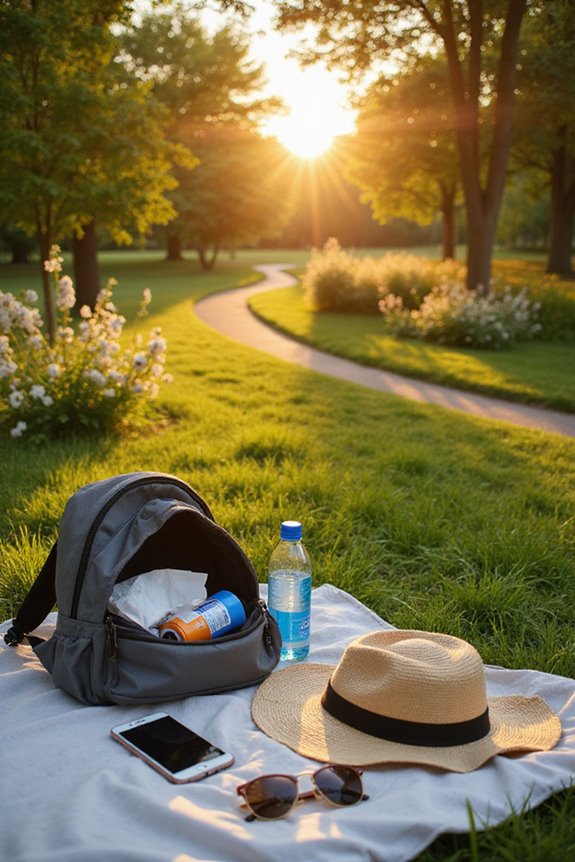
When is the best time to step outside and embrace the great outdoors without the constant threat of sneezing? Early morning is a fantastic choice, especially before sunrise. Pollen counts are at their lowest, and the morning dew keeps those pesky grains grounded. Plus, the cooler temperatures and decreased wind mean that allergy sufferers can enjoy a refreshing atmosphere without worry.
Alternatively, late afternoon can also be a great time. As the day winds down, pollen levels decline, and evening dew settles the air. It’s like nature’s own allergy relief! Just remember to avoid those mid-morning to early afternoon hours when pollen peaks, and you’ll be set for a sneeze-free adventure outdoors.
Allergy-Friendly Outdoor Activities to Consider
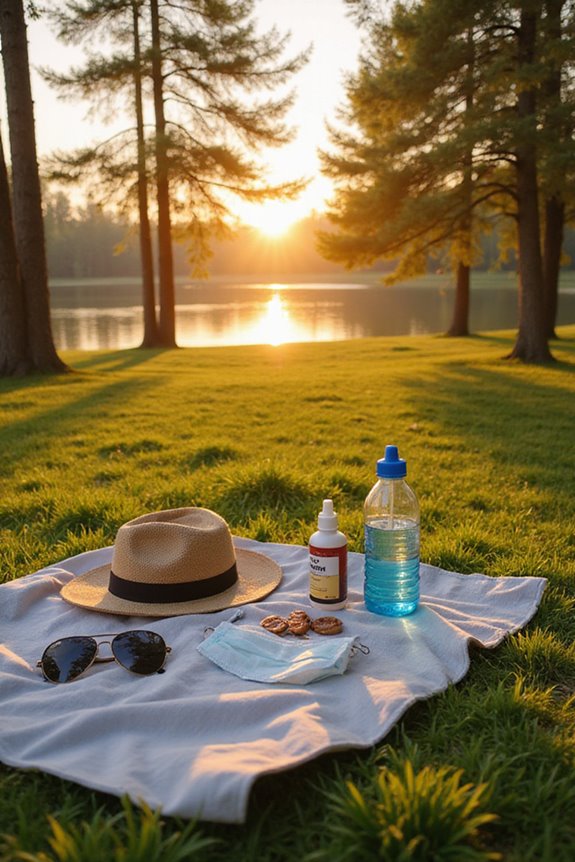
Finding outdoor activities that are friendly to allergy sufferers can feel like searching for a needle in a haystack, but it’s entirely possible to enjoy nature without the constant threat of sneezing fits. Consider planning allergy-friendly picnics, featuring low-allergen foods like fresh fruits and veggies, all while lounging in a shady spot. Nature walks can be a breeze too, especially if they center around observation rather than strenuous hiking, allowing for mindful breathing amidst the serenity. For those looking to garden, opting for non-allergenic plants like impatiens can make a world of difference. Finally, scenic drives through picturesque landscapes can provide enjoyment without risking pollen overload, making outdoor adventures enjoyable, allergy-free, and stress-free!
Protective Measures for Outdoor Outings
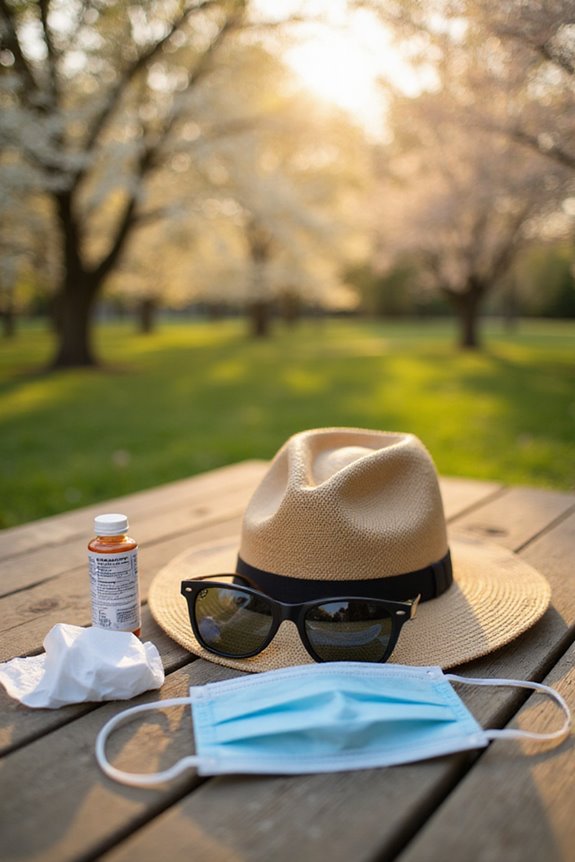
While it may seem like an uphill battle to enjoy outdoor outings during allergy season, a few simple protective measures can make a world of difference. First, understanding specific allergy triggers is essential; knowing what to avoid can help. When planning outings, checking pollen counts and scheduling activities during low pollen times is wise. Wearing a mask that filters particulates, especially on high pollen days, can be a game changer. Don’t forget about outdoor gear—goggles or sunglasses will shield those sensitive eyes. After a day out, showering and changing clothes can effectively remove pesky allergens. By incorporating these steps into daily routines, individuals can embrace the great outdoors while effectively allergy-proofing their experience.
Monitoring Pollen Counts and Weather Conditions

How can someone truly enjoy the great outdoors during allergy season without monitoring the ever-changing pollen counts and weather conditions? Understanding pollen measurement techniques is essential. Devices like the Burkard spore trap or automated monitoring systems, such as the BAA500 pollen meter, can provide valuable insights. These tools capture pollen data, which is often compiled into mobile apps and websites, offering real-time updates tailored to specific allergies. Plus, keeping an eye on weather conditions is just as important; dry, windy days can release high pollen counts, while a good rain can clear the air. By combining these resources, outdoor enthusiasts can better plan their activities, maximizing enjoyment while minimizing allergy woes. So, gear up and check those counts!
Managing Allergic Reactions and Asthma Symptoms
When the sun shines brightly and the outdoors beckons, managing allergic reactions and asthma symptoms can feel like a juggling act. To keep the fun rolling, effective symptom management is essential. Medication strategies like antihistamines can tackle sneezing and itching, while nasal corticosteroid sprays work wonders for congestion. For those with asthma, quick-relief inhalers are a must-have during adventures. Monitoring symptoms is vital—coughing or wheezing shouldn’t be ignored! Keeping a symptom diary helps identify triggers, ensuring outdoor time remains enjoyable. Remember to wear protective clothing, like long sleeves and wide-brimmed hats, to fend off pesky allergens. With these strategies, outdoor fun can continue, even during allergy season—because who wants to miss out on sunshine and fresh air?
Choosing the Right Locations for Reduced Exposure
Choosing the right locations for outdoor activities can make all the difference for those battling allergies, as a little foresight goes a long way in reducing exposure to pesky pollen. Coastal areas, with their invigorating saltwater breezes, often provide a safe haven for allergy sufferers, making beach outings a fantastic option. Meanwhile, mountainous regions typically boast lower pollen counts, thanks to their sparse allergenic plants. Imagine hiking a serene trail, free from the sneezes and sniffles! Additionally, opting for spots with fewer flowering plants or in elevated terrains can greatly lessen pollen exposure. By prioritizing these locations, outdoor enthusiasts can enjoy nature without the constant worry of allergy flare-ups, making every adventure a breath of new air.
Hydration and Medication Management During Activities
While outdoor adventures can be a revitalizing change, they’re often accompanied by the nagging presence of allergies. Proper hydration techniques are essential during these activities. Drinking at least eight glasses of water daily not only thins mucus but also helps flush out pesky allergens, keeping discomfort at bay. Warm liquids, like herbal tea, can soothe those irritated nasal passages too. When it comes to medication timing, always carry your prescription meds, and don’t forget over-the-counter antihistamines for quick relief. For those with serious allergies, an EpiPen is a must-have. By combining hydration with smart medication management, allergy sufferers can enjoy the great outdoors while minimizing symptoms and feeling invigorated, instead of just feeling stuffy!
Tips for Staying Comfortable While Outdoors
Outdoor activities can bring a revitalizing sense of freedom, but for those battling allergies, comfort often feels out of reach. To stay comfortable while enjoying the great outdoors, wearing the right outdoor gear is essential. Long sleeves and pants can shield skin from pesky pollen, while hats and sunglasses protect the eyes. A NIOSH-approved face mask can be a game-changer, especially during gardening. Timing is everything—opt for early mornings or windless days when pollen levels dip. Don’t forget to pack allergy-friendly snacks like fruits and nuts to keep energy levels up without triggering reactions. Afterward, a quick shower and fresh clothes can help wash away pollen, ensuring that the comfort continues long after the adventure ends.
Planning Ahead for Allergy-Friendly Adventures
When planning an allergy-friendly adventure, a little forethought can make all the difference between sneezing your way through the day and truly enjoying the great outdoors. Start by researching pollen counts to find the best allergy-friendly destinations, especially coastal areas where allergens are typically lower. Opt for low-allergen trails, like those winding through lush woods, and plan outdoor activity times early or late when pollen is at its lowest. If gardening sounds appealing, choose hypoallergenic plants and wear a mask. For a relaxed day, scenic drives or backyard camping can be delightful. Just remember to pack your allergy medication and snacks that are safe to munch on, ensuring your adventure remains enjoyable and stress-free.
Frequently Asked Questions
Can Indoor Activities Help Reduce Allergy Symptoms During Peak Season?
In a world where knights sought refuge from dragons, indoor exercises provided allergy relief during peak seasons. Engaging in such activities greatly reduced symptoms, allowing individuals to enjoy comfort while minimizing exposure to outdoor allergens.
What Are the Best Indoor Alternatives to Outdoor Exercises?
Exploring the best indoor alternatives to outdoor exercises, individuals find yoga classes and virtual workouts beneficial. These options enhance fitness levels while providing a comfortable environment free from outdoor allergens and weather-related challenges.
How Can I Prepare My Home for Allergy Season?
As a fortress shields against invaders, allergy-proofing essentials like sealed windows and HEPA filters enhance home ventilation. Regular cleaning and strategic air management create a sanctuary, safeguarding inhabitants from seasonal allergens lurking outside.
Are There Specific Diets That Can Help Alleviate Allergy Symptoms?
Research suggests that incorporating anti-inflammatory foods and seasonal fruits into diets may alleviate allergy symptoms. These dietary choices promote gut health and reduce inflammation, potentially improving overall immune responses related to allergies and enhancing well-being.
Can Pets Bring Outdoor Allergens Inside My Home?
Pets can transport outdoor allergens indoors, including pollen exposure, through their fur. Pet dander, combined with pollen from outside, markedly increases indoor allergen levels, posing challenges for individuals sensitive to these allergens.

